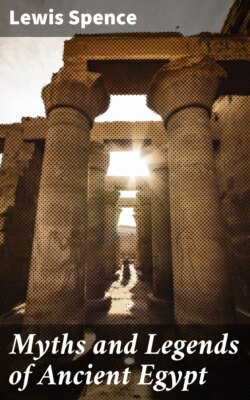Читать книгу Myths and Legends of Ancient Egypt - Lewis Spence - Страница 12
На сайте Литреса книга снята с продажи.
Deities of the Pyramid Texts
ОглавлениеIn order to understand this earliest fixed phase of religious thought in Egypt, it is necessary to pass in brief review the deities alluded to in the Pyramid Texts, and for the moment to regard them separately from the rest of the Egyptian pantheon. In doing so we must beware of definitely labelling these conceptions with such names as 'water-god,' 'thunder-god,' 'sun-god,' and so forth. Despite the labours of the last half-century, the science of mythology is yet in its infancy, and workers in its sphere are now beginning to suspect that mere variants or phases of certain deities, which are by no means separate entities, have in many cases been credited with an individual status they do not deserve. The deities of the Greek and Roman pantheons are doubtless good examples of gods whose attributes are finally fixed. Thus one may say of Mars that he is a war-god, and of Pallas Athene that she is a goddess of wisdom, but these were merely the attributes possessed by these deities which were most popular and uppermost in the public consciousness. Recent research has proved that most of the Greek and Roman deities are traceable to earlier forms, some of which possess a variety of attributes, others of which are more simple in form than the later conception which is developed from them. Again, many deities which exhibit some particular tendency are necessarily connected with other natural forms. Thus many rain gods or goddesses are connected with thunder and lightning. Possession of the lightning arrow frequently implies a connexion with hunting or war. All moon-gods are deities of moisture, and preside over birth. Some deities of rain preside also over the winds, thunder and lightning, the chase and war, general culture, and so forth. A sun-god, as lord of the vault of heaven, can preside over all the meteorological manifestations thereof. He is god of growth, of wealth, because gold possesses the yellow colour of his beams, of travelling, because he walks the heavens, and he rules countless other departments of existence. From polytheism may evolve in time a condition of monotheism, in which one god holds complete sway over mankind—that is, one deity may become so popular, or the priestly caste connected with him so powerful, that all other cults languish as his spreads and grows. But, on the other hand, polytheism, or the multiplicity of deities, may well spring from an early monotheism,[8] itself the child of a successful fetish or totem, for the attributes of a great single god may, in the hands of a people still partially in the animistic stage, become so infused with individuality as to appear entirely separate entities. In dealing, then, with the gods alluded to in the Pyramid Texts, several of which are obviously derivative, we must recollect that although in a manner it is necessary to affix to them some more or less definite description, it will be well to bear in mind the substance of this paragraph.
We are not at present finally considering the natures or characteristics of the deities mentioned in the Pyramid Texts, but merely affording such a brief outline of them as will give the reader some idea of Egyptian religion in general during the early dynasties.
The goddess Net, or Neith, who is mentioned in the Pyramid Texts of Unas, is a figure in which we descry a personification of moisture or rain, because of her possession of the arrow, the symbol of lightning. The hawk-headed Horus, probably originally a hawk totem, is one of the manifestations of the sun-deity, from whom he may have evolved, or with whom he may have been confounded. Khepera, also found in the Unas Texts, is another form of the sun. His possession of the beetle glyph is symbolical of the manner in which the sun rolls over the face of the sky as the Egyptian beetle or scarabæus rolled its eggs over the sand. Khnemu, the ram-headed, whose name signifies 'the moulder' or 'uniter,' was probably the totemic deity of an immigrant race who had achieved godhead, and perhaps monotheism, or at least creatorship, in another sphere, and who had been accepted into Egyptian belief with all his attributes. Sebek, the crocodile-god, Ra and Ptah, two other forms of the sun-god, Nu, the watery mass of heaven, are also alluded to in the Pyramid Texts of Unas and Teta, as is Hathor.
